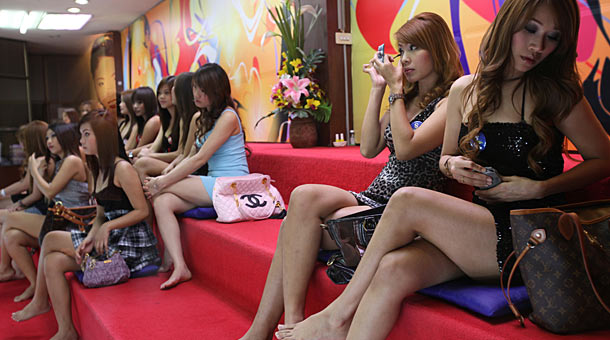
Rather than make some sort of grand statement about prostitution, it lets its audience draw its own conclusions.

Rather than make some sort of grand statement about prostitution, it lets its audience draw its own conclusions.
Whores’ Glory is the conclusion to director Michael Glowagger’s globalization trilogy. Glowagger puts his focus on one of the oldest and most controversial jobs in his triptych on prostitution. Looking at three different countries, Glowagger and cinematographer Wolfgang Thaler highlight the complexities that come with treating people as commodities. The result may be a little on the nose at times but it’s compelling material that’s gorgeously shot by Thaler and Glowagger.
The film opens with what may be its most striking sequence visually. A group of women standing at a window overlooking a busy street below start dancing and gyrating to attract potential clients. They use laser pointers to attract people’s attention until they snag a group of young men who come up to join them. It’s a surreal but beautifully shot scene, setting up the first part taking place in a Bangkok brothel called The Fishbowl. The Fishbowl gets its name because of the giant aquarium-like room all the women sit in while the clients pick and choose which woman they want to have sex with (the women wear numbers on their chest and are grouped into different price levels). The way things are set up feel degrading, but the women don’t appear to be bothered by the arrangement at all.
The Bangkok segment is fueled by a sense of casualness from everyone involved. In Bangkok the sex industry appears to be run like any other business, with the effects being shown through the workers at The Fishbowl. Glawogger shows women grabbing a bite to eat together, having conversations about trying to get a second job or what nationality of clients they like the least. Glawogger holds off the biggest surprise for the end of the segment when it’s revealed that some workers end up spending their paychecks on male prostitutes at a bar nearby. The camera doesn’t need to do anything except observe when a male and female prostitute debating over which one will end up paying the other. The bizarre nature of the conversation speaks for itself.

The second segment, taking place in Bangladesh at the ironically-named City of Joy, is pure chaos. The City of Joy is an old apartment building where men simply come in and find a woman who will take them to their room for the right price. Of course the right price doesn’t mean much since the first thing we see is a woman offering herself for two hundred dollars before being negotiated down to fifty in a matter of seconds. The City of Joy is incredibly claustrophobic. Hallways are narrow with people constantly dodging the camera as it goes through them. The filthy living conditions only heighten the depravity of the place as we see the abusive relationships of the Madams in the building along with the large number of underage prostitutes working. When one of these underage workers starts crying on camera about how “there’s no path for us”, it’s the first time we see someone explaining the emotional toll of the job.
The final part of Whores’ Glory, set in an area called The Zone in Mexico, first seems like a breath of fresh air after Bangladesh. The cramped hallways of the City of Joy are replaced with a wide area. Looking like an old motel, men drive through The Zone looking for women who have their rooms open for business. It’s evident that Glowagger compiled his film so that each location would be worse than the last, and The Zone manages to be even worse than Bangladesh. This is also the first time where the cameras go behind the closed doors and show one of the women at work with a client in what might be the funniest parts of the entire film. The Zone is filled with more comic relief than the first two segments, a notable one involving an older prostitute drunkenly telling stories about her glory days (she boasts about having up to 40 johns in one day). The light touches might have felt necessary as a contrast to the depressing way of life in The Zone. The final scene involving two workers smoking crack together contemplating suicide ends things on a deservedly dark note.
Whores’ Glory is just as much Wolfgang Thaler’s film as it as Michael Glowagger’s. From the bright lights of Bangkok to the cramped spaces of Bangladesh and muddy areas of Mexico, Thaler brings a sense of beauty to each one. Glowagger’s interviews with some of the women and tendency to stage some moments might feel like exploitation or cheap emotional grabs, but these moments work effectively. Rather than make some sort of grand statement about prostitution, Glowagger merely observes the way things are and lets its audience draw its own conclusions. Whores’ Glory shows how prostitution and the sex industry can be a necessary evil. There’s an ugly side to all of it no matter how professional the conditions are, but there’s a high demand. Glowagger’s display of the range of consequences that come with the sex trade make for one of the best documentaries of the year.